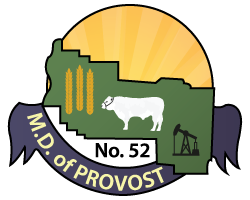MD of Provost Clubroot of Canola Policy
CLUBROOT POLICY
Policy Statement
The MD of Provost No. 52 recognizes that Clubroot of Canola is a serious problem and supports the principle to control the spread of Clubroot which is a designated pest under the Agricultural Pests Act.
Procedures
- Random inspections will be conducted within the MD of Provost by the Agricultural Fieldman or by an inspector appointed by the MD of Provost Council.
- Designated inspectors will follow procedures that are established by Agricultural Services administration on sampling techniques and protocol for entering upon private land. Inspectors entering land when testing for Clubroot will wear protective, disposable boot covers or wear footwear that can be disinfected using a bleach solution.
- Positive identification of Clubroot shall be obtained by approved laboratory tests from at least two independent labs.
- When land has been verified positive for Clubroot the landowner will be notified in writing with a legal notice in accordance with the Province of Alberta’s Agricultural Pests Act.
- The notice will prohibit the growth of canola, mustard or any other Clubroot susceptible crop on the affected land for a period of 3 years (1 in 4). This seeding prohibition includes Clubroot resistant varieties and they will not be permitted to be grown during this period. It is recommended that producers use Clubroot resistant varieties of seed when planting susceptible crops following the prohibited seeding period.
- A person who has an interest in the infected land as an owner or occupant and feels personally aggrieved by a notice issued by an inspector under section 12 of the Agricultural Pests Act, may appeal in writing to the local authority of the MD of Provost within ten days of the Notice.
- Any land sown to such a crop in contravention of the terms of a written notice will be destroyed as per the Agricultural Pests Act. Volunteer canola and crucifer weeds must be controlled on infested fields before three weeks of growth has occurred to prevent the production of new resting spores.
- All adjacent landowners and/or occupants to the affected land will be notified in writing that Clubroot is present. Alberta Agriculture and Irrigation, AFSC, Research and parties with genuine commercial interest staff may also be given the location of affected lands. Release of information in these situations is at the discretion of the Agricultural Fieldman and Municipal Council.
- The landowner and/or occupants of the land will have the responsibility to follow best management practices set out by Alberta Agriculture and Irrigation to reduce the spread of the disease with the movement of soil and equipment.
- Equipment Sanitation Recommended equipment sanitation involves following this sequence of steps as recommended by The Alberta Clubroot Management Plan:
- All producers should follow the practice of cleaning soil and crop debris from field equipment before transport from all fields. The most critical step in cleaning equipment is physical dirt removal sweeping off loose soil knocking or scraping off soil lumps.
- For risk averse producers or with heavy infestations, additional cleaning steps will slightly decrease the risk of spread, but will involve considerably more work and
expense:- After removal of soil lumps, wash equipment with a power washer. O Finish by misting equipment with disinfectant. Recommended products include 1 to 2 per cent active ingredient bleach solution (UFA carries 12 per cent sodium hypochlorite in 5-gallon pails or 45-gallon drums), or HyperOx or EcoClear. The use of a disinfectant without first removing soil is not recommended because soil inactivates most disinfectants. A twenty to thirty minute wet period is necessary for good efficacy.
- Disinfectant footbaths can be an effective first line of defense in a biosecurity program. However, footbaths are not able to completely eliminate biosecurity risks in all situations. Disposable foot coverings should be utilized where possible and in combination with a foot bath to more fully minimize biosecurity risks associated with soil-borne diseases like clubroot.
- If you are a landowner or renter with a field that has tested positive for clubroot, it is recommended to seed, spray, and/or harvest this land last to avoid soil movement from the infected field.
———-
Private landowners and industry are responsible for negotiating their own access and sanitation agreements with each other and the Municipality Pest Control Inspector will not be getting involved in private negotiations unless it is an enforcement issue regarding a positive Clubroot location.
Steps 1 & 2 will apply when moving equipment from any areas in or adjacent to a known infested area within and/or into the M.D. of Provost.
Any equipment entering or moving within the Municipality from a quarter known to have Clubroot must follow steps 1, 2 & 3 (Optional).
Any equipment entering the Municipality from an area not known to have Clubroot must follow steps 1 & 2.
The MD of Provost shall review this policy on an annual basis.
